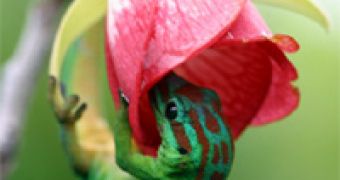Geckos are really some of the most amazing lizards. They are mostly known for their ability to climb vertical walls and walk on ceilings using their adhesive toes. The secret behind this amazing ability lies in an unique quick-release mechanism that permits geckos to strongly adhere to a surface, but then detach with ease, unlike conventional adhesives that either adhere weakly and detach easily (like Post-it notes) or are strong and hard to remove (like duct tape). The mechanism is connected to tiny hairs (setae) that form weak molecular forces called van der Waals. And some geckos can be 35 cm long! The shape of the hair is important; spatula-shaped ends on the hairs give the strongest adhesion.
Only geckos and some lizards (rock lizards, whiptails and Komodo dragons) are known to give birth through parthenogenesis: the female lays fertile eggs without any fertilization.
The most popular pollinators are bees, butterflies, hummingbirds, sunbirds, white-eye birds, pollen-eating bats and some marsupials. But what about geckos? The survival of the Trochetia flower in the Mauritius Island (Indian Ocean) is linked to its pollinator, the blue-tailed day gecko. Out of over 4,300 known lizard species, just 71 are nectar-eating pollinators, and 95% of them are flower-visiting lizard species from islands. There are island plants with special adaptations for attracting their lizard pollinators, like yellow or red nectar in Trochetia flowers (almost all the other species produce clear nectar).
Geckos are also the only known reptiles that vocalize to attract a mate and 8 species of flying gecko lizards (Ptychozoon and Cosymbotus) from southeastern Asia can glide! These arboreal lizards mimic tree bark with their color patterns. Their toes, limbs, sides and Tails present skin flaps as an adaptation for gliding. Their tail and body too are flattened. When the gecko leaps into the air, the flaps are used to generate lift and allow the gecko to control its fall.
And if you have heard about ants herding plant fleas for sugary juices, find out that geckos do it too. The day geckos from the forests of Madagascar are amongst the most vividly colored vertebrates, and unlike other geckos which are nocturnal and have cat-eyes (vertical pupils), this species is diurnal and has rounded pupils. The lizard was filmed while begging a bug for honeydew during the footage recorded for the BBC One series Life In Cold Blood. The lizard keeps on nodding its head at the plant hopper, until the insect releases small balls of honeydew on which the gecko feasts. Ants are known to defend these insects against predators; probably the presence of the geckos keep away the predators of the plant hoppers.

 14 DAY TRIAL //
14 DAY TRIAL //